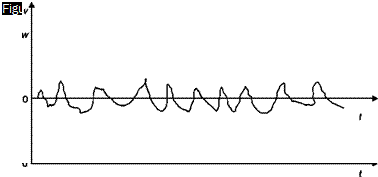Measurements in turbulent flows
If the stream velocity varies in time, both in absolute value and in direction, turbulent regime, the situation can be summarized as in Figure 3.21:
 |
U(t) = U+ u(t) V(t) = v(t) W(t) = w(t)
where the instantaneous value of the fluctuations of velocity components have been indicated with lower case letters and by U the average speed in a time interval much larger than the period of oscillations.
Since, obviously, the average values of fluctuations are identically zero,
u = v = w = 0
to have a measure of turbulence along the three axes it is necessary to make the square of the signal, thus eliminating the negative areas, make the average (Figure 3.22) and then extract the square root (the so-called root mean square value, rms)
vu W w
Turbulence intensity is defined as the ratio between the root of the arithmetic average of the rms values of the three components of the unsteady velocity and average speed:
|
u + v + w2 |
|
|
І |
3 |
|
U |
|
T = |











